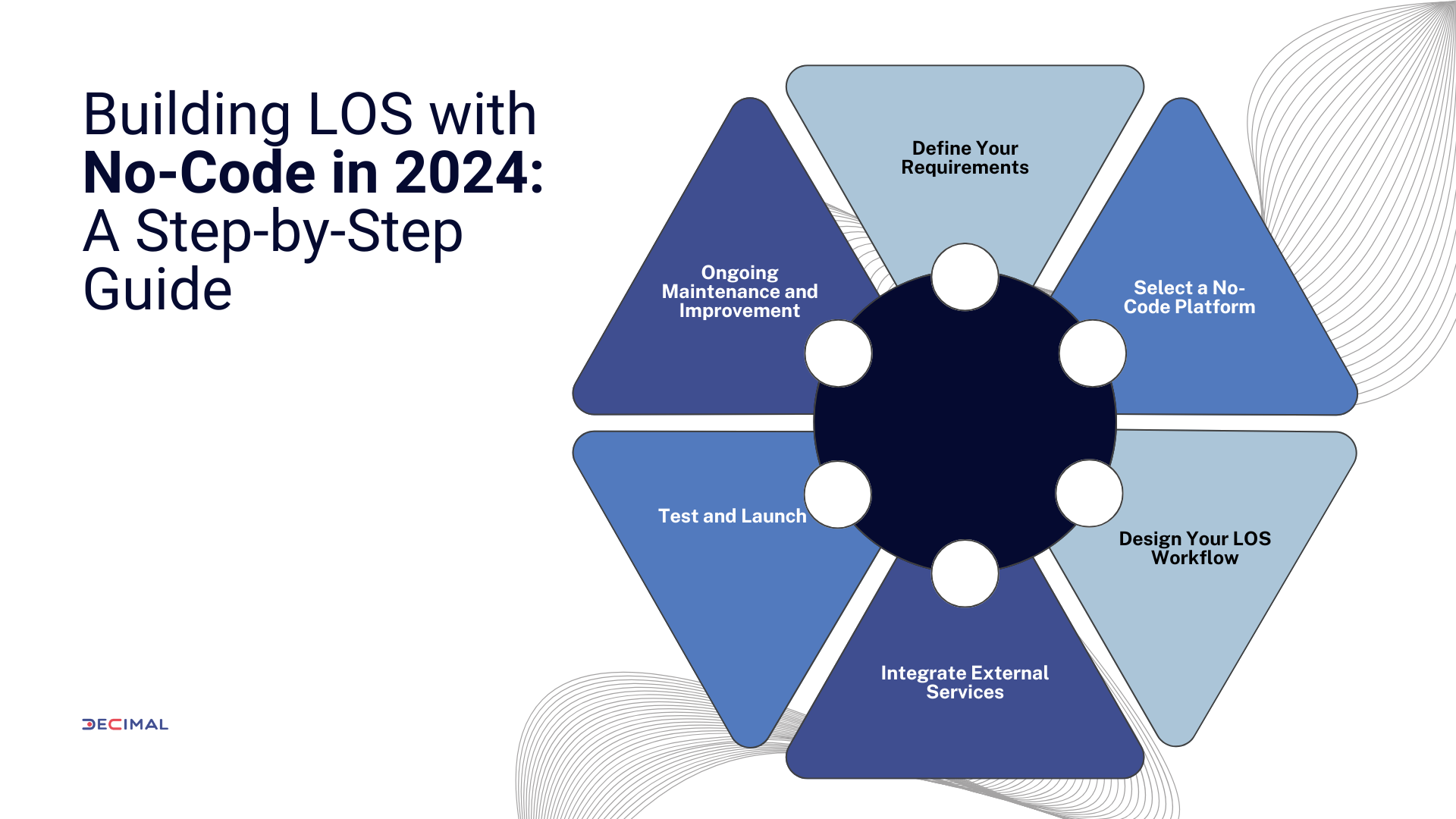The loan origination software (LOS) landscape is constantly evolving, offering exciting opportunities for lenders in the BFSI (Banking, Financial Services, and Insurance) industry.
Whether you’re a large enterprise, a small and medium-scale business (SMB), or a daring startup, a robust LOS can revolutionize your lending process. Moreover, this also leads to increased efficiency, faster loan approvals, and happier customers.
Table of Contents
- Understanding the importance of LOS
- The rise of no-code solutions: Building LOS for everyone
- Building LOS with No-Code in 2024: A step-by-step guide
- Key considerations for building no-code LOS
- Benefits of building a no-code LOS for different business types
- Future trends in LOS development
- Taking the next step
- FAQs
- People also ask related questions
This guide dives deep into building LOS in 2024, exploring key considerations and showcasing the potential of no-code solutions for businesses of all sizes.
Understanding the Importance of LOS
Loan Origination Systems serve as the backbone of lending operations for banks, financial institutions, and credit unions. LOS automates and digitizes key processes such as applicant data capture, credit decisions, document management, and compliance tracking.
It enables organizations to accelerate loan processing times, minimize risk, and deliver a seamless borrower experience. In an increasingly competitive market, having a reliable LOS in place is not just advantageous; it’s pivotal for staying ahead of the curve.
However, before we delve into building LOS, let’s solidify our understanding of the lending origination process.
This involves several key steps
- Loan Application: Borrowers submit loan applications electronically or via paper forms.
- Verification and Underwriting: Lenders verify borrower information, assess creditworthiness, and determine loan eligibility.
- Document Collection: Required documents, such as tax returns and paystubs, are gathered for loan approval.
- Approval and Disbursement: Once approved, loan documents are finalized, and funds are dispersed to the borrower.
This process can be cumbersome and time-consuming, especially with manual data entry and document management.
LOS streamlines these steps, automating tasks, boosting efficiency, and increasing borrower satisfaction.
The Rise of No-Code Solutions: Building LOS for Everyone
Traditional approaches for building a LOS have their limitations. No-code solutions, however, offer a compelling alternative for businesses of all sizes
Simplified Development: No-code platforms employ drag-and-drop interfaces and pre-built components, eliminating the need for coding expertise. Business users can design and build workflows without relying on programmers.
Reduced Costs: No-code development requires fewer resources compared to in-house development, making it a cost-effective option for startups and SMBs.
Increased Agility: They offer faster development cycles, allowing businesses to adapt to changing market demands quickly.
Scalability: No-code solutions can scale alongside your business. As your lending volume increases, the platform can expand to accommodate your needs.
Improved User Experience: No-code tools enable building user-friendly interfaces for both borrowers and loan officers, simplifying the loan application and management process.
Check out: Fueling Growth: No-Code Tools for Streamlined Lending for Gold Loans
Building LOS with No-Code in 2024: A Step-by-Step Guide
Ready to harness the power of no-code for your lending business?
Here’s a step-by-step guide to help you build your LOS in 2024

Define Your Requirements
Analyze your current lending process and identify areas for improvement.
Determine the features and functionalities your LOS needs. This could include loan application forms, document management, credit scoring, workflow automation, and reporting capabilities.
Select a No-Code Platform
Research and compare leading no-code platforms.
Consider factors like platform features, pricing plans, ease of use, and security compliance. Many options in the market offer robust features for building LOS solutions.
Design Your LOS Workflow
Map out the various stages of the loan origination process within the no-code platform. Design intuitive and user-friendly interfaces for both borrowers and loan officers.
Integrate External Services
Many no-code platforms offer APIs (Application Programming Interfaces) that facilitate integration with external systems.
This might include integration with credit bureaus for credit scoring, document storage solutions, or accounting software.
Test and Launch

Once satisfied, launch your no-code LOS to a limited group of users. Gather feedback and iterate based on their experience. After successful testing, roll out the LOS to your entire user base.
Ongoing Maintenance and Improvement
LOS is never truly finished. Regularly monitor system performance and user feedback. Utilize the no-code platform’s analytics tools to identify areas for improvement. Update workflows and features as needed to optimize your lending process.
Key Considerations for Building a No-Code LOS
While no-code offers a compelling alternative, there are some key factors to consider before building your LOS
Data Security
Data security is paramount in the lending industry.
Ensure your chosen no-code platform offers robust security features, including data encryption, access controls, and compliance with relevant regulations.
Also Read: Compliance Considerations for Security of No-Code Platforms
Scalability
Choose a no-code platform that can scale alongside your business growth. Consider your projected loan volume increase and ensure the platform can handle future demands.
Regulatory Compliance
The lending industry is heavily regulated. Verify that your no-code platform allows building LOS solutions that comply with relevant industry standards and data privacy regulations.
Integration Capabilities
Consider your existing technology stack and ensure the no-code platform offers seamless integration with your existing systems for data exchange and streamlined workflows.
Benefits of Building a No-Code LOS for Different Business Types
No-code empowers businesses of all sizes to build their own LOS solutions.
Here’s how it caters to specific needs
Startups and SMBs
- Reduced Costs: No-code eliminates the need for expensive developer resources.
- Faster Time to Market: Quickly launch a functional LOS without lengthy development cycles.
- Flexibility and Agility: Easily adapt your LOS to changing market demands with no-code tools.
Large Enterprises
- Improved Efficiency: Automate manual tasks and streamline the lending process.
- Enhanced User Experience: Create user-friendly interfaces for both borrowers and loan officers.
- Reduced Development Time: Build and deploy new LOS features faster compared to traditional methods.
Future Trends in LOS Development

Looking ahead, the future of LOS development is poised for innovation and advancement. Emerging technologies such as AI, machine learning, blockchain, and predictive analytics are set to reshape the LOS landscape.
Furthermore, they offer new opportunities for enhancing functionality, improving decision-making processes, and delivering unparalleled customer experiences.
By staying abreast of these trends and embracing technological advancements, organizations can position themselves for success in the dynamic world of loan origination.
Taking the Next Step
Building LOS, whether through traditional or no-code methods, requires careful planning and execution. Consider conducting a comprehensive needs assessment to determine the best approach for your business.
Research leading no-code platforms, and explore their features and functionalities in detail. Most platforms offer free trials, allowing you to experiment and build prototypes before committing.
Building a robust LOS can significantly enhance your lending operations. Embrace the power of no-code and unlock the potential for a more efficient and borrower-centric lending experience in 2024 and beyond.
FAQs (Frequently Asked Questions)
1. What is a Loan Origination System (LOS)?
– A Loan Origination System (LOS) is a software platform used by banks, financial institutions, and credit unions to streamline the loan application process from start to finish.
It encompasses various components such as applicant data capture, credit decisions, document management, and compliance tracking.
2. Why is LOS important in the BFSI industry?
– LOS plays a crucial role in the BFSI (Banking, Financial Services, and Insurance) industry by enhancing operational efficiency, reducing manual errors, and improving customer experience.
It helps organizations accelerate loan processing times, minimize risk, and ensure compliance with regulatory requirements.
3. How can LOS be tailored for different business needs?
– LOS solutions can be customized to meet the specific requirements of enterprises, large-scale businesses, SMBs, startups, and complex application businesses.
By adapting workflows, integrating with existing systems, and accommodating regulatory nuances, LOS platforms can cater to the unique needs of any organization.
4. What role does no-code development play in LOS development?
– No-code development platforms empower businesses to build custom LOS solutions without extensive coding knowledge.
These platforms enable rapid development, cost-effectiveness, and flexibility, allowing organizations to bring their LOS visions to life quickly and efficiently.
5. What are the key steps to building LOS in 2024?
– The key steps to building LOS in 2024 include conducting a needs assessment and evaluating and selecting a vendor, customizing and integrating the LOS, ensuring compliance with regulatory requirements, etc.
6. What are some future trends in LOS development?
– Future trends in LOS development include the adoption of emerging technologies such as artificial intelligence, machine learning, blockchain, and predictive analytics.
These technologies are poised to reshape the LOS landscape, offering new opportunities for enhancing functionality, improving decision-making processes, and delivering unparalleled customer experiences.
People Also Ask Related Queries
- How do I choose the right Loan Origination System (LOS) vendor?
Evaluate vendors based on scalability, integration, compliance, and support services to choose the right LOS vendor.
- What are the benefits of integrating LOS with existing systems?
Integration enhances data flow and efficiency, streamlining processes and improving overall system performance.
- How can LOS help startups streamline their lending operations?
LOS automates processes, reduces manual effort, and ensures compliance, enabling startups to streamline lending operations efficiently.
- What are the compliance requirements for LOS implementations?
Compliance requirements include adhering to regulatory standards such as GDPR, CCPA, and industry-specific regulations to protect customer data.
- What are the best practices for optimizing LOS performance?
Best practices include monitoring key performance indicators, gathering user feedback, and implementing iterative improvements to enhance LOS performance.